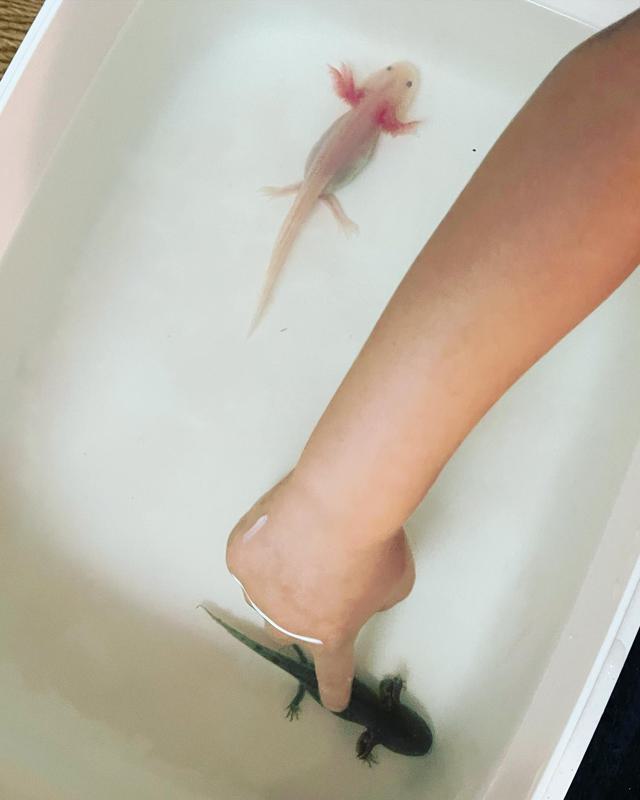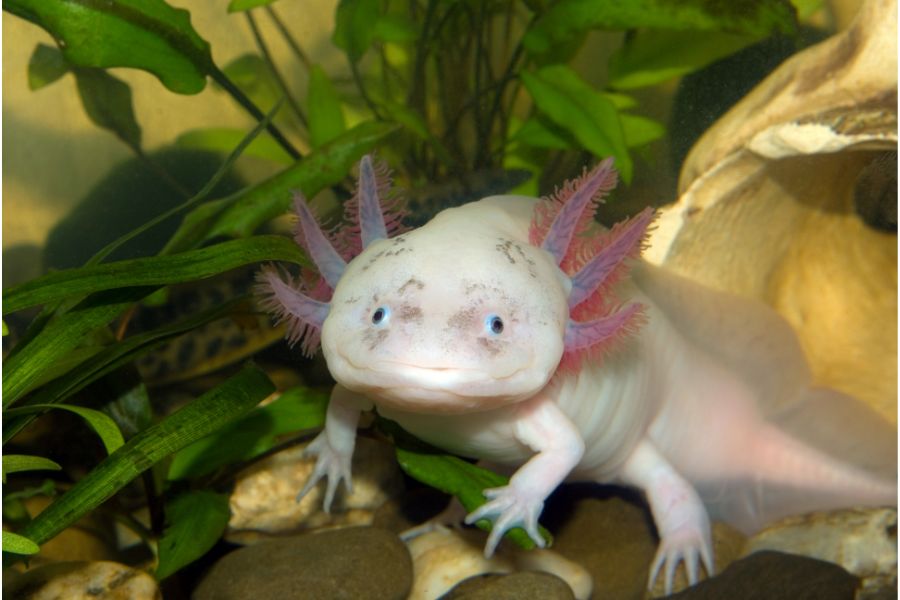The axolotl, commonly called the Mexican salamander, is a fascinating animal that is becoming extremely popular among many animal lovers.
These unique creatures belong to Mexico and are widely kept in captivity as pets due to their curious and docile nature.
However, many people wonder if it’s safe to hold an axolotl. You can hold these creatures for a brief time, but experts advise not to.
These creatures are delicate and can easily be injured, stressed, or harmed by human interaction. This article will delve into the reasons if holding axolotl is safe, ways to carefully touch them as well the risks associated with it.
Can You Hold or Touch an Axolotl?
Axolotls are intriguing aquatic creatures that have become popular pets in recent times. These small amphibians are well-known for their unique ability to regenerate their body parts.
However, some people may not be aware of the proper way to handle axolotls. There may be curiosity about whether they can be touched or handled, but it’s important to note that the axolotl experts recommend against it.
Axolotls are delicate creatures with sensitive skin, and any rough handling can cause injuries or even death. Additionally, axolotls have a slime layer on their skin that serves as protection from bacterial infections.
Touching or removing this slime layer can make the axolotl more vulnerable to disease. The Animal Welfare Organization RSPCA echoes this sentiment, stating that “axolotls should not be held unless necessary.”
If handling an axolotl is required, it should only be done briefly and with the utmost caution. Axolotls are susceptible to substantial stress from being handled or touched, as well as from changes in their habitat.
While holding or touching an axolotl is not advisable, there are other ways to interact with these fascinating creatures. Observing an axolotl from outside the tank can be just as interesting, and providing them with a variety of hiding places and structures to explore can keep them entertained and engaged.
Additionally, feeding an axolotl can be a great way to interact with them, and providing live food like brine shrimp or bloodworms can help them maintain their natural hunting instincts.
Do Axolotls Like Being Handled or Touched?
Axolotls are remarkable for their capacity to regenerate missing body parts and are highly regarded for their scientific significance.
Nonetheless, it’s not advisable to touch or handle an axolotl as they are fragile creatures that may be easily harmed or distressed by human contact.
Axolotls have thin, permeable skin that can easily be damaged by human touch. Touching or handling an axolotl can remove its protective slime layer, which can leave them vulnerable to bacterial infections.
Axolotls are also susceptible to stress due to environmental shifts and may become anxious when being handled. Experiencing stress can lead to disease or even death, so it’s vital to avoid handling or touching them except when absolutely necessary.
It’s important to realize that axolotls are less likely to form close bonds with humans than other pets, such as dogs or cats. Since they are unable to recognize their owner, they do not desire to be handled or touched.
Can You Hold an Axolotl out Of Water?
Holding an axolotl out of water for an extended period of time is not recommended. As amphibians, axolotls need water to breathe since they absorb oxygen through their skin.
Axolotls could be temporarily removed from the water for a few seconds; however, doing so for a long period might be harmful to the animal’s health and well-being.
An axolotl may become stressed and have trouble breathing when it is taken out of the water, which might have negative effects on its health. They may also have dry skin, which makes them more vulnerable to bacterial infections.
Axolotls must be handled carefully, and their aquatic environment should never be disturbed unless absolutely required.
If moving an axolotl out of the water is required, like during tank maintenance, it should only be done quickly and with the assistance of a veterinarian or knowledgeable pet owner.
Axolotls should be kept wet by placing them in a shallow container with a damp towel in these situations.
How Do You Handle Your Axolotl Properly?
Axolotls must be handled carefully and attentively to maintain their well-being. Here are some pointers for taking care of your axolotl:
- Always wet your hands – Axolotls have delicate skin that can be easily damaged, so it is essential to wet your hands before handling them to avoid removing their protective slime layer.
- Use both hands – It’s crucial to support the axolotl’s full body when carrying it. Always support the head with one hand and the tail with the other.
- Avoid squeezing – Axolotls have soft, delicate bodies, and squeezing them can cause injury or even death. Be gentle when handling them, and avoid putting too much pressure on any part of their body.
- Keep handling to a minimum – As discussed earlier, axolotls do not enjoy being handled or touched. Limit handling only when necessary, such as during tank cleaning or when relocating them to a different tank.
- Watch for signs of stress – Axolotls can grow anxious when handled, so it’s vital to keep an eye out for symptoms like quick movements or body twisting. Return the animal to its tank gently if you see any symptoms of stress.
- Wash your hands – Hands must be carefully washed before handling an axolotl in order to prevent spreading any dangerous bacteria to the creature.
What Is the Safest Holding Technique?
Axolotls should be held with their full body supported and kept submerged at all times. The steps are as follows:
- Use a small container or net – To avoid having to chase your axolotl around their tank, it is recommended to use a small container or net to scoop them up gently.
- Keep them in the water – Once you’ve placed your axolotl in the container or net, keep it in the water to avoid stressing or harming it.
- Support the axolotl’s complete body – Support the axolotl’s head and tail with one hand each while supporting the rest of the body with the other.
- Hold their head above water – The axolotl must always have its head above the water in order to avoid accidental drowning.
- Limit holding time – As mentioned earlier, axolotls do not enjoy being handled or touched, so limit the amount of time you hold them to only when necessary.
- Carefully put them back in their tank – Once you’ve finished holding your axolotl, put it back in its tank carefully, making sure it’s back in the water.
What Are the Risks Associated with Holding or Touching an Axolotl?

Holding or interacting with an axolotl carries a number of hazards. These are a few examples:
- Injury – Axolotls have delicate bodies, and improper handling can result in injury or even death. Squeezing, dropping, or mishandling an axolotl can cause broken bones or damage to its internal organs.
- Stress – As already mentioned, handling or touching axolotls may be stressful for them because they dislike it. Axolotls can get agitated when disturbed, which can cause them to lose their protective slime coating and become more vulnerable to illnesses.
- Disease – Axolotls have the potential to transmit to humans illnesses like salmonella. You run the danger of getting one of these illnesses if you handle an axolotl, especially if you don’t thoroughly wash your hands afterward.
- Amputation – Axolotls are capable of regenerating lost limbs; however, this process can take time and be uncomfortable for the animal. If an axolotl is mishandled and loses a limb, it may take longer to regenerate or not regenerate at all.
- Water quality – When you handle an axolotl, you may transmit germs, pollutants, or oils from your skin to the water in its container. As a result, the water quality may decline, and the axolotl’s chance of getting sick may rise.
Also Read:
FAQs
What Should I Do if My Axolotl Becomes Stressed During Handling?
If your axolotl becomes stressed during handling, it is best to return them to their tank as soon as possible. Providing hiding places in their tank can also help them feel more comfortable and secure.
Can Axolotls Bite?
While axolotls rarely bite, their tiny fangs are capable of rupturing the skin. To prevent any unintentional bites, it’s critical to handle them delicately.
Is It Possible to Train Axolotls to Be More Comfortable with Handling?
Axolotls can’t be trained to accept being handled or interacting with people as other pets can. They are lonely beings that want to remain unaccompanied. It’s crucial to respect their personal space and to only handle them when absolutely required.
Can Axolotls Be Held While Being Transported?
Axolotls shouldn’t be held during transit since this might stress them out and even injure them. It is ideal to transport them in a bag or container that is safe, secure, and has sufficient air and water.
Conclusion
While axolotls are intriguing and one-of-a-kind pets, they should not be handled or stroked regularly. Axolotls need a certain habitat to thrive; thus, it’s crucial to bear in mind that too much handling might stress or even injure the creature.
When handling is required, it must be done carefully, cautiously, with the right support, and in a water setting. By using safe handling procedures and giving your axolotl an appropriate habitat, you can make sure they’ll be pleased, healthy, and active during their entire lifespan.
Your axolotl will be pleased if you remember to respect their space.

